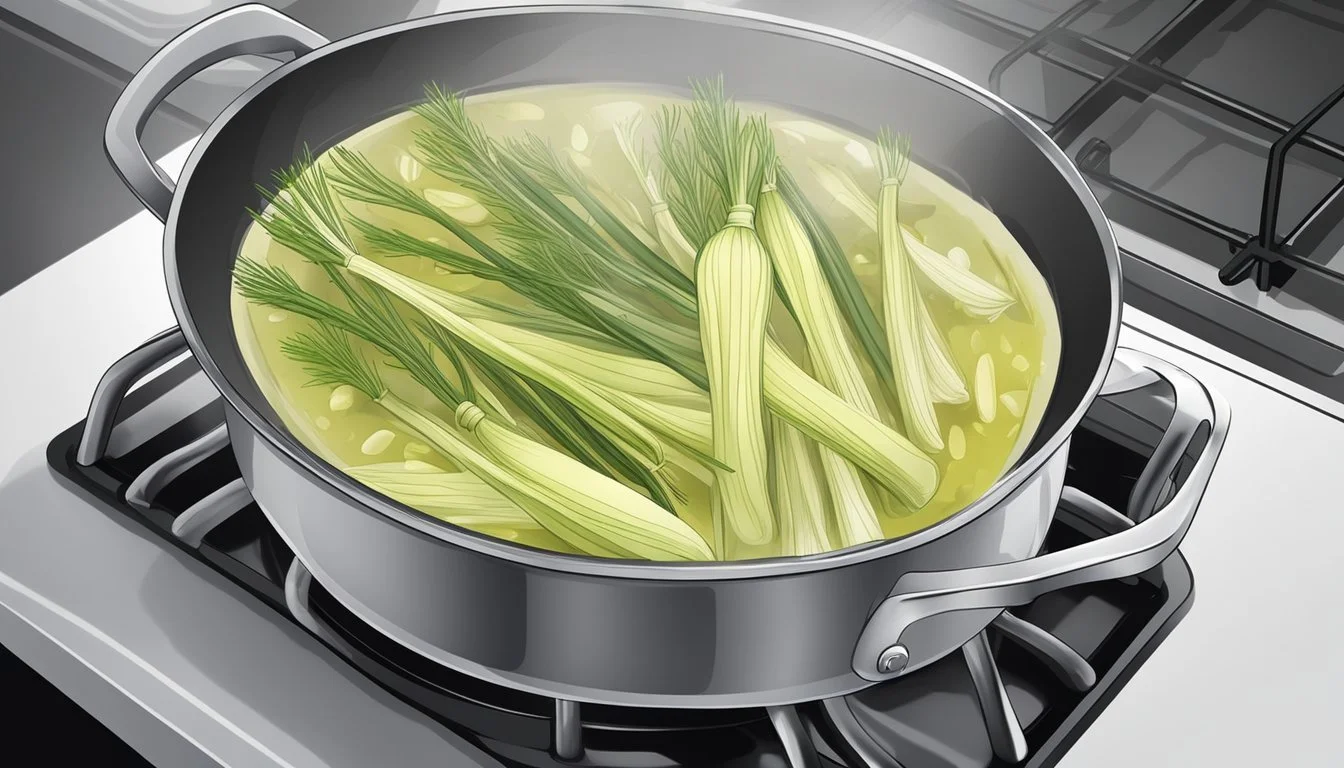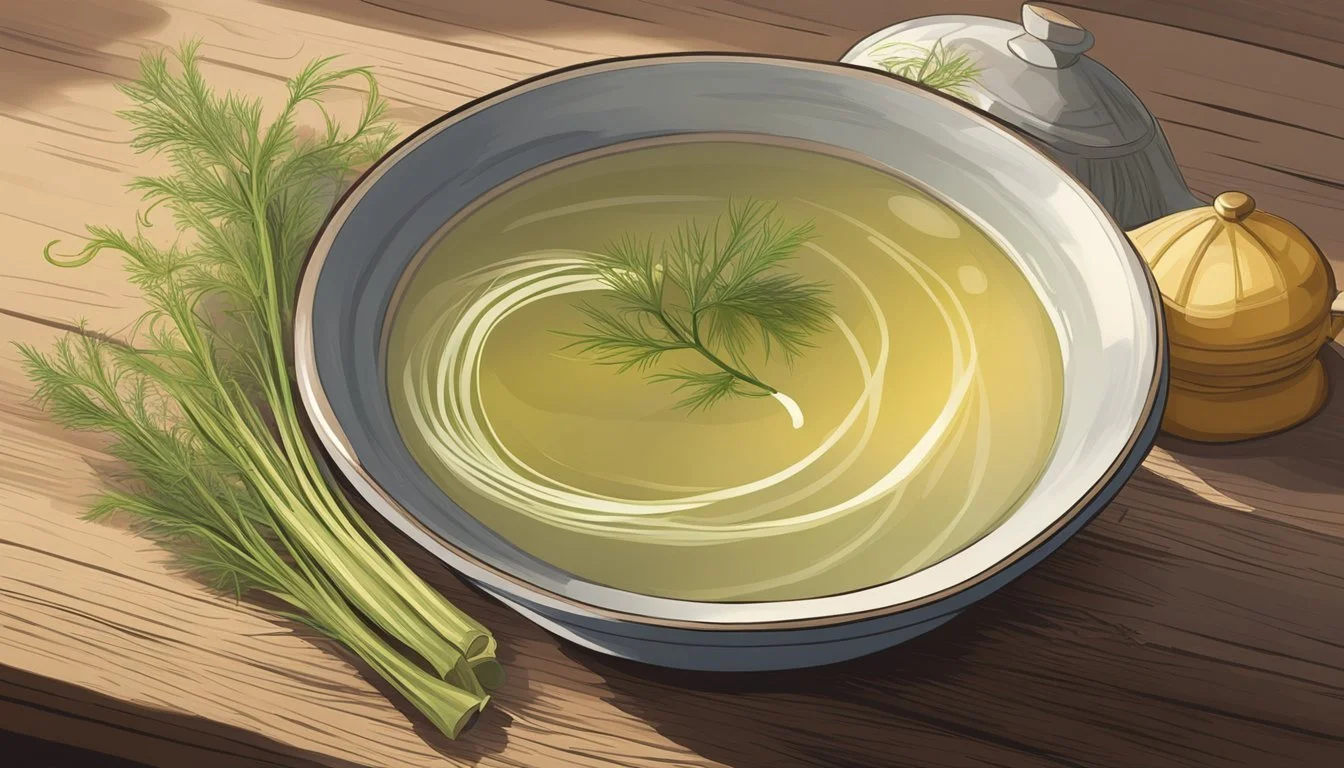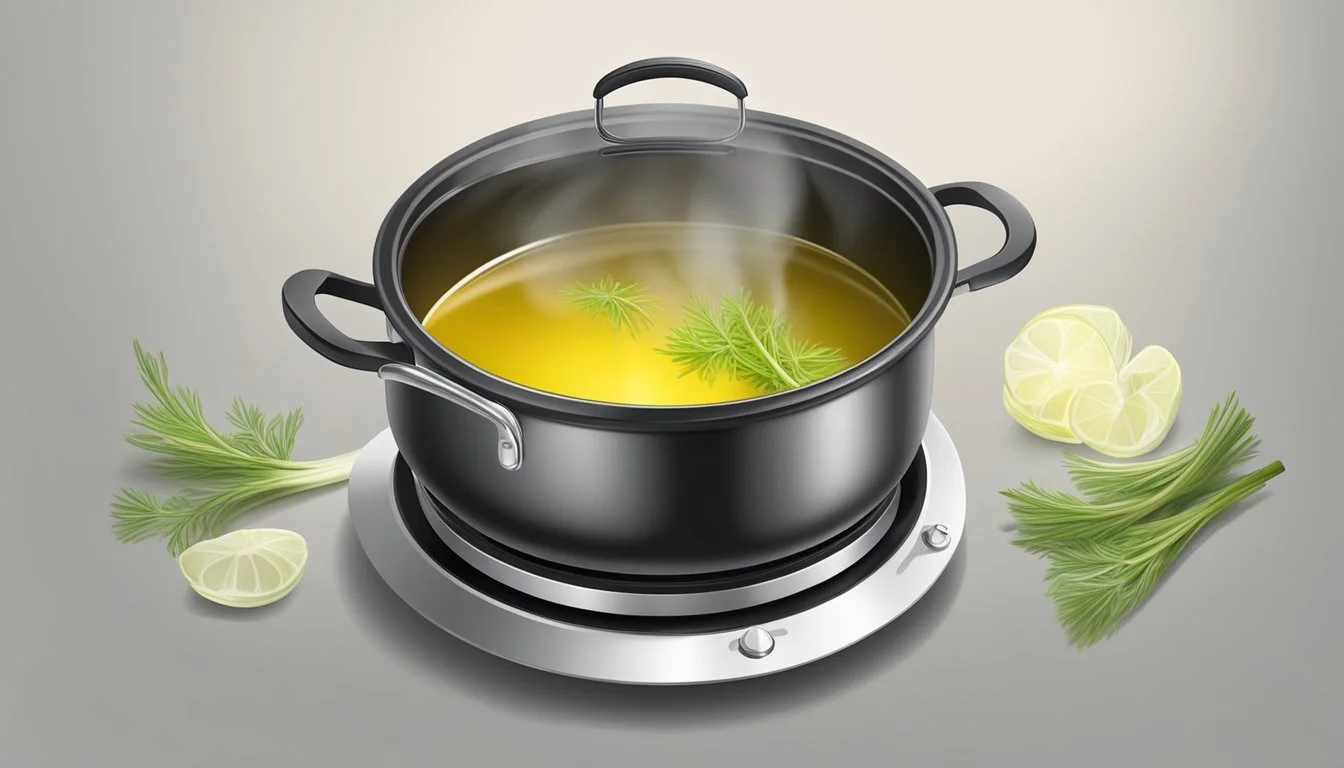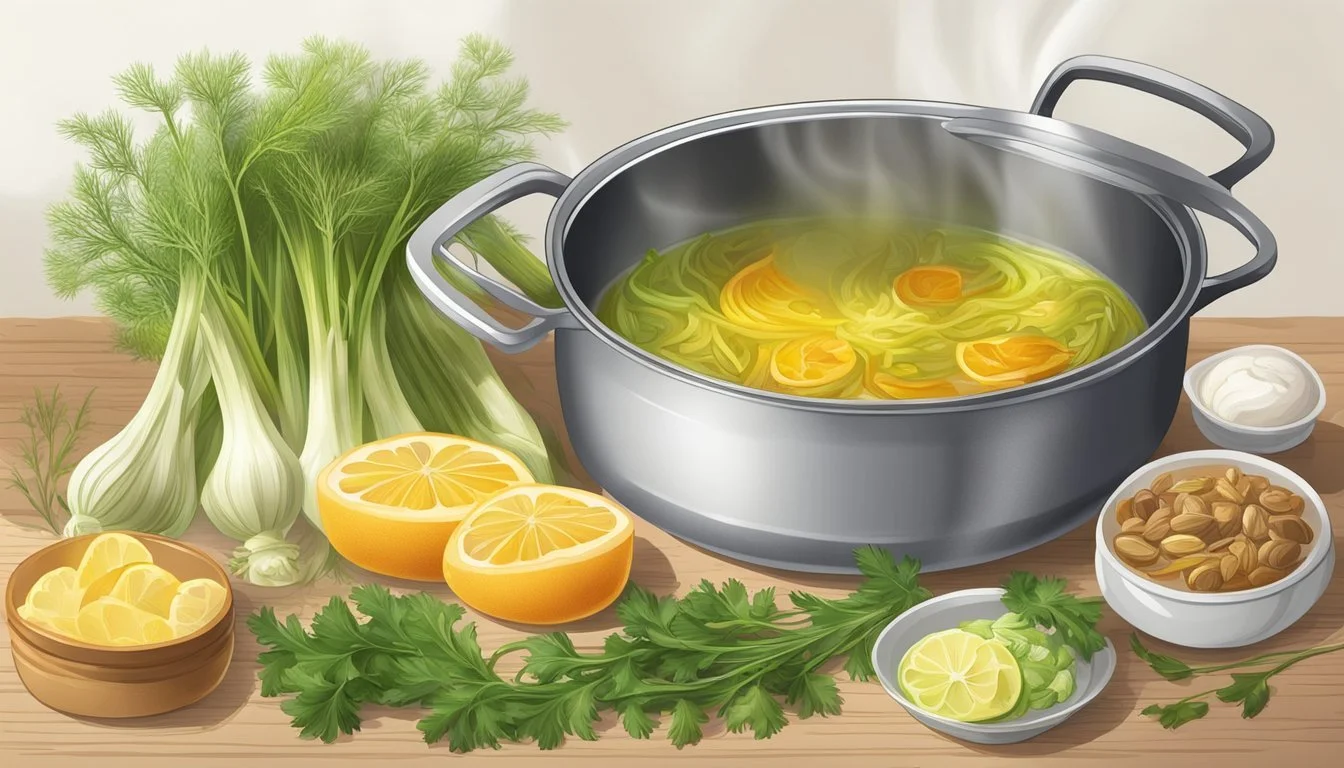Fennel Stalk Broth
Crafting a Savory and Aromatic Soup Foundation
Fennel stalk broth emerges as a culinary secret weapon for home cooks and chefs alike. Its aromatic profile, bearing a distinctive anise flavor, adds a nuanced depth to a myriad of dishes. The fronds and stalks, which are often discarded in favor of the bulb, can be repurposed into a fragrant broth. This not only maximizes the use of the vegetable but also imparts a sweet, herbaceous base to soups (What wine goes well with soups?), braises, and stews.
The process of creating fennel stalk broth involves simmering the vegetable's remnants along with complementary herbs and mirepoix to extract the flavor. The anise flavor inherent in fennel is subtle, yet it has the capability to endow dishes with a complexity that elevates them without overwhelming the palate. Its versatility is evident—it can be adjusted to support the starring ingredients of a dish or to stand on its own as a soothing soup base.
The broth itself is not only flavorful but also a testament to a sustainable approach in the kitchen, ensuring that every part of the fennel plant has a purpose. The infusion of its sweet, aromatic quality into a liquid base opens up possibilities for creative and resourceful cooking. Chefs may use this broth as a foundation for soups, as a poaching liquid for fish, or as a braising medium for vegetables, demonstrating its adaptability and the potential to become a staple in cooking practices that celebrate flavor and sustainability.
Identifying Fennel Components
In the culinary universe, fennel is admired for its versatility. Each part of the fennel plant, from bulb to fronds, is edible and boasts a distinctive anise flavor that can enrich a wide range of dishes.
Characteristics of Fennel Bulb
The fennel bulb is the white, bulbous base of the plant. Its crunchy texture makes it ideal for adding a crisp element to salads. Identifying a fennel bulb is straightforward — look for a clean, white bulb that shows no signs of browning. When selecting, the bulbs should be firm and free of cracks or bruising.
Utilizing Fennel Stalks
Fennel stalks shoot up from the bulb and have a more rigid texture and intense flavor. They can be used similarly to celery in soups and broths. For a fennel stalk broth, chop the stalks into pieces and sauté them before adding to a broth base, enhancing it with their aromatic profile.
Health Benefits and Nutritional Value
Fennel is not just about taste; it's also packed with nutrition. It's a good source of vitamin C, fiber, potassium, and other micronutrients. Raw fennel can provide a healthy crunch to diets, while the stalks and fronds contribute both to the palate and to wellness. Adding chopped fennel fronds to dishes is an excellent method to utilize their delicate aniseed flavor and nutritional benefits without waste.
Preparing the Base
A fennel stalk broth serves as a fragrant, anise-flavored foundation for various recipes. Creating this aromatic base involves a blend of fresh fennel components, water, and a careful selection of seasonings to achieve a balanced flavor profile.
Creating the Broth
To begin crafting the broth, one first gathers fennel stalks and fronds—typically the byproducts of using the fennel bulb in other preparations. After a thorough rinse, these components are placed in a large pot and submerged in water. The ratio is crucial: for every two cups of chopped fennel stalks and fronds, one should add approximately four cups of water. Bringing this mixture to a boil and then allowing it to simmer gently enables the flavors to infuse the liquid, creating a base that is both flavorful and versatile. It is advisable to simmer until the liquid volume is reduced by half, or until the broth's flavor is sufficiently concentrated. The duration of simmering impacts the intensity of the fennel flavor.
Quantity Ingredient Preparation 2 cups Fennel stalks/fronds Chopped 4 cups Water -
Seasonings and Spices
Seasoning the broth appropriately is essential to its final taste. One should include salt to enhance the natural flavors within the broth. A conservative use of black pepper can add a subtle heat, which rounds out the sweet notes of the fennel. Aromatic herbs such as dill, thyme, and basil can be introduced to complement the anise-like quality of the fennel. For more elaborate or specific dishes, spices like saffron for color and luxurious flavor or a pinch of cayenne pepper for heat are excellent additions. Every seasoning added should be considered and measured to maintain the broth's delicate balance.
Salt: Start with a small amount, adjust to taste.
Black Pepper: Use freshly ground for best flavor.
Herbs: Add dill, thyme, or basil for complexity; fresh is preferable.
Spices: A pinch of saffron adds depth; cayenne pepper can be sprinkled for a spicy note.
Cooking Techniques
When preparing fennel for a flavorful broth, certain techniques can enhance the vegetable's natural fragrant, anise-like qualities. Through roasting, sautéing with aromatics, and braising, one can extract a depth of flavor for a robust fennel stalk broth.
Roasting Fennel
Roasting fennel is a simple way to intensify its sweet flavor. One begins by preheating the oven to 400°F (200°C). The bulb is then cut into wedges, with the core removed, and tossed in olive oil, seasoned with salt and pepper. Arrange the fennel on a baking sheet in a single layer to ensure even cooking and caramelization. Roast in the preheated oven for 25-30 minutes until edges are browned and the fennel is tender.
Sautéing with Aromatics
To begin sautéing, one must heat a pan over medium-high heat, adding a combination of olive oil and butter for richness. Next, add thinly sliced fennel along with chopped onion and minced garlic, both known for their robust aromatics. Sauté until the vegetables are golden and fragrant. This technique not only imbues the fennel with other flavors but also adds complexity to the broth.
Braising for Depth
Braising fennel requires a blend of liquid—typically white wine, lemon juice, or vegetable broth—and gentle, sustained heat. One begins by bringing the liquid to a boil, adding seasoned fennel pieces, and then reducing the heat to allow the fennel to simmer. Cover and cook for approximately 30 minutes. Through braising, the fennel becomes tender and fully imbued with a rich and aromatic essence ideal for broth.
Recipe Variations
Fennel stalk broth serves as a versatile base that can be tailored to enhance various dishes. By incorporating different proteins or keeping it plant-based, one can craft a broth that elevates the main ingredients' flavors.
Meat and Poultry Pairings
Fennel stalk broth pairs excellently with pork and poultry, lending its anise notes to the natural flavors of the meats. For a Mediterranean twist, chefs can simmer pork sausages (What wine goes well with pork sausages?) or pork chops (What wine goes well with pork chops?) in the broth, amplifying the savory aspects with fennel's unique taste. Similarly, a roast chicken finds new depths of flavor when rested on a bed of fennel stalks and slowly cooked in a broth-infused environment.
Fish and Seafood Combinations
The anise flavor of fennel stalk broth complements fish and seafood dishes (What wine goes well with seafood dishes?) exceptionally well. A classic bouillabaisse can benefit from the broth as a base, intensifying the flavors of the mussels, (What wine goes well with mussels?) shellfish, (What wine goes well with shellfish?) and other seafood elements. Poaching salmon in fennel broth will infuse delicate anise notes into the fish, perfect for a refined and flavorful entrée.
Vegetarian and Vegan Options
For vegetarian and vegan dishes, fennel stalk broth can be enriched with various cheeses and baked vegetables. Adding Parmesan rinds to the simmering broth creates a rich, umami backdrop for vegetable soups. Fennel's licorice notes also blend well with feta, enhancing baked vegetables with a fragrant, herbaceous quality.
Dish Accents
Fennel stalk broth provides a versatile flavor foundation for a variety of dishes. Enhancing this base with thoughtful garnishes and complementary oils or cheeses can elevate the final presentation and taste.
Garnishing and Serving
A chef's choice of garnish for dishes utilizing fennel stalk broth can diversify texture and enliven flavor. Adding chopped parsley brings a fresh, vibrant finish, while a squeeze of lemon can imbue brightness, balancing the broth's deep tones. Aesthetically, a serving platter can be lined with fennel fronds for a thematic and visually appealing touch. Fine sea salt sprinkled just before serving ensures a burst of flavor with each bite.
Adding Cheeses and Oils
Incorporating cheeses and oils into recipes with fennel stalk broth introduces richness and depth. Parmesan or Parmigiano cheese, freshly grated over the dish, offers a salty and slightly nutty contrast to the broth's anise flavor. Extra-virgin olive oil, drizzled just before serving, provides a buttery complexity that complements the aromatic profile of the broth. These additions should be used judiciously to enhance, not overshadow, the delicate essence of the fennel.
Culinary Inspirations
Fennel stalk broth, with its unique anise flavor, provides a versatile foundation for a variety of culinary applications. It enriches dishes with a delicate, aromatic quality that is cherished in both Italian and French cuisines.
Influences of Italian Cuisine
Italian cuisine often incorporates fennel in its myriad forms, notably within pasta and soup creations. Fennel pasta dishes, such as those combining bucatini – a thick spaghetti-like pasta with a hole running through the center – benefit from the broth's nuanced notes, complementing the robust flavors of tomatoes and olive oil intrinsic to Italian cooking. Dishes like gnocchi, a type of potato dumpling, also gain depth with the addition of a fennel-infused sauce or as a base for the cooking liquid.
French Influence
The French have long harnessed the power of fennel in their cooking, most famously in the seafood stew known as bouillabaisse. Originating from the port city of Marseille, traditional chicken bouillabaisse incorporates fennel stalk broth to balance the robust flavors of the sea. Moreover, the use of Pernod – an anise-flavored liqueur – in various French recipes highlights the affinity of French cuisine for the sweet, licorice-like quality of fennel. Gratins in French cuisine often integrate thinly sliced fennel for an aromatic lift, with the broth sometimes employed to infuse the dish with additional fragrance.
Serving and Presentation
When presenting a dish that features fennel stalk broth, the focus should be on showcasing the broth’s clarity and depth of flavor, as well as complementing it with the right components to elevate the dining experience.
Plating Techniques
For plated dishes, fennel stalk broth serves as a delicate, anise-scented base that can be poured tableside to add a sense of elegance. A centerpiece like grilled fish can be positioned in the center of a shallow bowl, allowing the golden broth to surround it without masking its charred beauty. When serving a rack of lamb, the broth can be introduced as an accent, drizzled lightly to complement the rich flavors of the meat, particularly fitting for an Easter celebration. Use of fresh herbs as garnish adds color while emphasizing the broth's herbal notes.
Social Media Showcase
Visual appeal is paramount when sharing on platforms like Instagram and Pinterest, where food aesthetics are as crucial as taste. Here, the translucent quality of the fennel stalk broth should be highlighted through the choice of dishware, with light-colored bowls providing a contrast that accentuates the liquid's purity. Capture the steam rising from the broth to convey warmth, and ensure natural lighting to make the dish inviting. Posts should tag relevant hashtags such as #fennelbroth and #gourmetpresentation to engage with like-minded food enthusiasts.
Storage and Reheating
When creating a fennel stalk broth, ensuring it retains its fragrant qualities and prevents spoilage is essential. Reheating should also preserve the broth’s anise flavor without diminishing its fresh and aromatic character.
Preserving Freshness
To store fresh fennel stalk broth, one should cool the broth to room temperature before refrigerating. The broth can be kept in an airtight container, which helps maintain the freshness for up to 5 days. If one has a larger batch or wishes to extend the storage duration, freezing is an effective method. Pour the cooled broth into freezer bags or an ice cube tray for easier portioning. When frozen, fennel stalk broth can last for up to 3 months. Remember to label the containers with the date of storage to keep track of the broth’s age.
Refrigeration: Up to 5 days in an airtight container
Freezing: Up to 3 months in suitable containers
Best Practices for Reheating
Reheating fennel stalk broth should be done gently to preserve its delicate flavors. One should thaw frozen broth in the refrigerator overnight before reheating. When ready to reheat, transfer the broth into a pot and warm it over low to medium heat, stirring occasionally. It is imperative to avoid boiling the broth as high heat can alter the flavor profile. The broth should be heated until it is just about to simmer, which is typically around 165°F (74°C). For convenience, reheated broth can also be enjoyed in a variety of dishes ranging from soups to risottos.
Defrosting: Thaw overnight in the refrigerator
Reheating Temperature: Approximately 165°F (74°C), until hot but not boiling
Fennel in Salads and Starters
Fennel's crisp texture and licorice-like flavor make it a unique and refreshing addition to salads and appetizers. With its versatility, one can easily create aromatic and distinct dishes that serve as a delightful beginning to any meal.
Creating Fennel Salads
Fennel salads offer a crisp and refreshing taste, perfect for a light starter or side dish. To create shaved fennel salad, one can thinly slice the fennel bulbs using a mandolin for uniformity and mix with a simple dressing of olive oil, lemon juice, salt, and pepper. This can be further enhanced by adding ingredients like walnuts for a crunchy texture and a nutty flavor. Presentation is key, so arranging the shaved fennel in a carpaccio style and garnishing with fennel fronds can elevate the visual appeal of the dish.
Fennel Salad Ingredients:
Shaved fennel
Extra virgin olive oil
Fresh lemon juice
Salt and black pepper
Walnuts (optional)
Parmesan cheese, grated (optional)
Fennel fronds, for garnish
Small Plates and Appetizers
When it comes to starters, fennel can be a key component in an array of small plates. Fennel pairs well with salami, offering a balance between the sweet, anise flavor of the fennel and the savory, richness of the meat. Incorporation into mixed antipasti or as a component of a charcuterie (What wine goes well with charcuterie?) board adds a fresh, palate-cleansing counterpart to heavier cured meats (What wine goes well with cured meats?) and cheeses. Moreover, these fennel-enhanced starters are typically easy to make, requiring minimal prep time and can be assembled quickly for serving.
Fennel Appetizer Pairing Suggestions:
Assorted salami and cured meats
Mixed olives
Roasted nuts
Cheeses
Fresh bread or crackers










